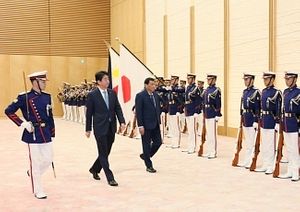On Friday, a Japanese destroyer arrived in the Philippines as part of a goodwill visit. The interaction was another demonstration of the ties between the two countries in the maritime realm and part of an active week for bilateral defense ties.
As I have observed before in these pages, despite lingering uncertainties and some refocusing following the election of Duterte, Japan-Philippines defense ties have nonetheless continued strengthening in some areas of the maritime realm as part of their broader partnership (See: “Japan-Philippines Defense Relations Under Duterte: Full Steam Ahead?”).
That comes as no surprise. Japan has been looking to strengthen ties with Southeast Asian states, including defense ties (See: “Japan Eyes New Coast Guard Body for ASEAN States”). Meanwhile, the Philippine military, including the Philippine Coast Guard and the Philippine Navy, need all the help they can get from allies and partners like the United States, Japan, and Australia. The Philippines has limited capability to cover over 7,000 islands with a tenth of the world’s coastline amid a series of challenges ranging from the South China Sea to terrorism (See: “Where is the Philippines Coast Guard in its Military Modernization?”).
Japan’s assistance to the Philippines includes several lines of effort, from capacity-building to training to defense equipment transfers. One manifestation of this relationship that was in the headlines this week was the maiden deployment of a Japanese-donated patrol pane to a shoal disputed between the Philippines and China in the South China Sea (See: “Why Japan’s New Military Aircraft Gift to the Philippines Matters”). The Philippine military said that the TC-90 Beechcraft King Air aircraft flew around Scarborough Shoal on its first mission for the Philippine Navy without encountering a challenge from the Chinese Coast Guard.
On February 2, in yet another demonstration of the military ties between the two countries, a Japanese destroyer arrived in the Philippines for a three-day visit. The JS Amagiri, which has one patrol helicopter and around 200 personnel, will be in the Philippines until February 4, according to information disclosed by the Philippine Navy earlier this week. This is reportedly the first such visit by a Japanese military vessel to the Philippines for 2018.
According to the Philippine Navy, the destroyer, which was escorted by the PN vessel BRP Rajah Humabon to its designated anchorage area, will participate in a range of activities during its visit. This includes courtesy calls on Philippine officers, a shipboard tour of the JS Amagiri, goodwill activities like basketball and soccer, as well as a Passing Exercise (PASSEX) that will cap off the port visit.
Reflecting on the significance of the visit in what was an active week for Japan-Philippines defense relations, Captain Koji Saito, commander of Escort Division Two of the JMSDF, noted that the visit, along with the transfer of the TC-90s, represented “remarkable proof that shows our strong navy-to-navy relations,” in remarks reported by Philippine media outlets.































